Corporate Accounting Report: Charter Hall Reit Unit Analysis
VerifiedAdded on 2020/05/16
|9
|2405
|41
Report
AI Summary
This report provides a comprehensive analysis of corporate accounting principles, focusing on the financial statements, equity, and tax implications of Charter Hall Retail Reit Unit. The report examines the company's financial position, including contributed equity, reserves, and accumulated losses. It further explores the company's tax expenditure, current and deferred tax assets and liabilities, and the impact of the Australian taxation legislation on its financial reporting. The analysis highlights that the company is not obligated to pay income tax due to its constitution, which distributes income to unit holders. The report also discusses the treatment of GST payments and provides a detailed overview of the company's financial performance and tax strategies. The report utilizes the latest annual report of Charter Hall Retail Reit Unit to support the analysis.
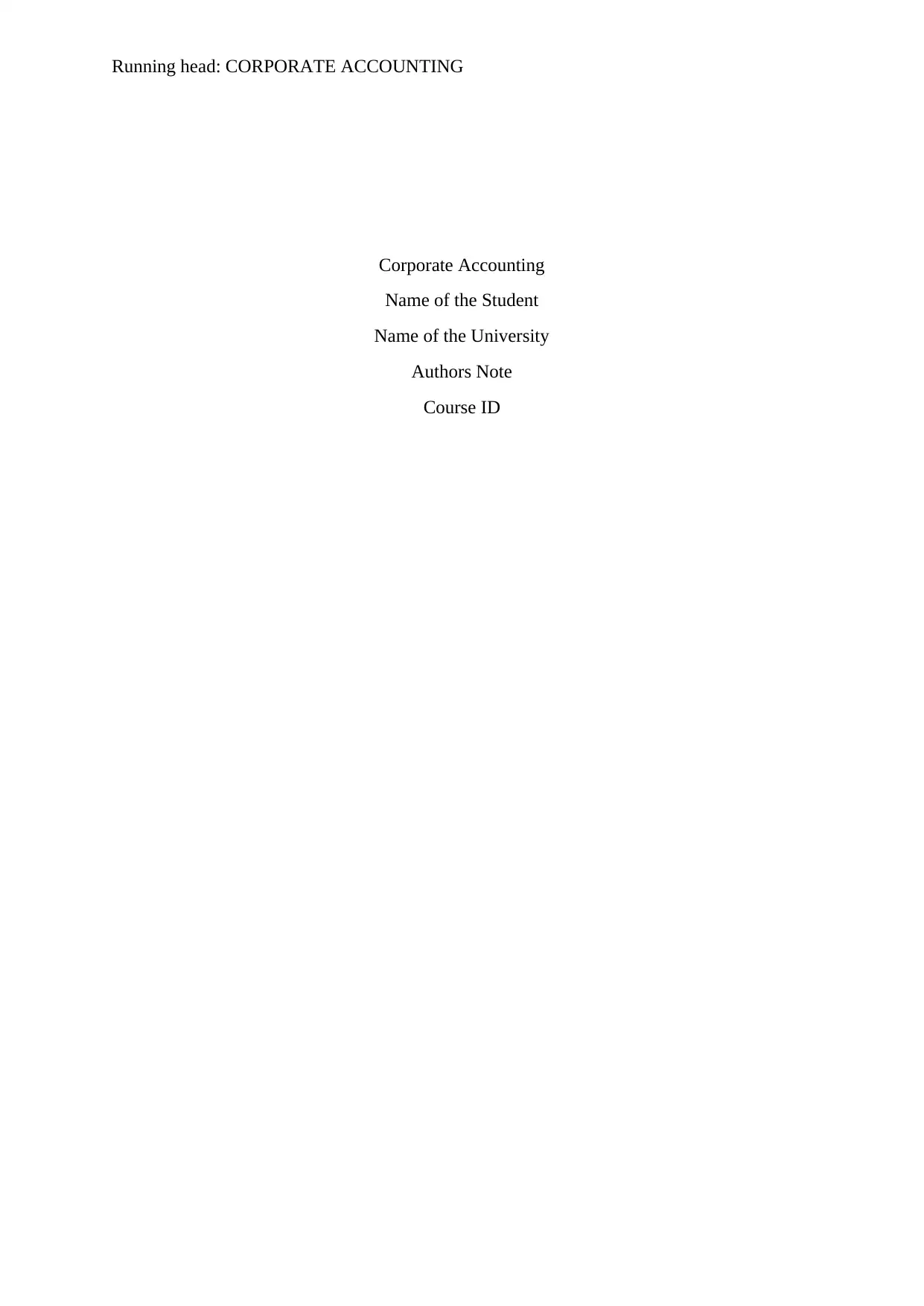
Running head: CORPORATE ACCOUNTING
Corporate Accounting
Name of the Student
Name of the University
Authors Note
Course ID
Corporate Accounting
Name of the Student
Name of the University
Authors Note
Course ID
Secure Best Marks with AI Grader
Need help grading? Try our AI Grader for instant feedback on your assignments.
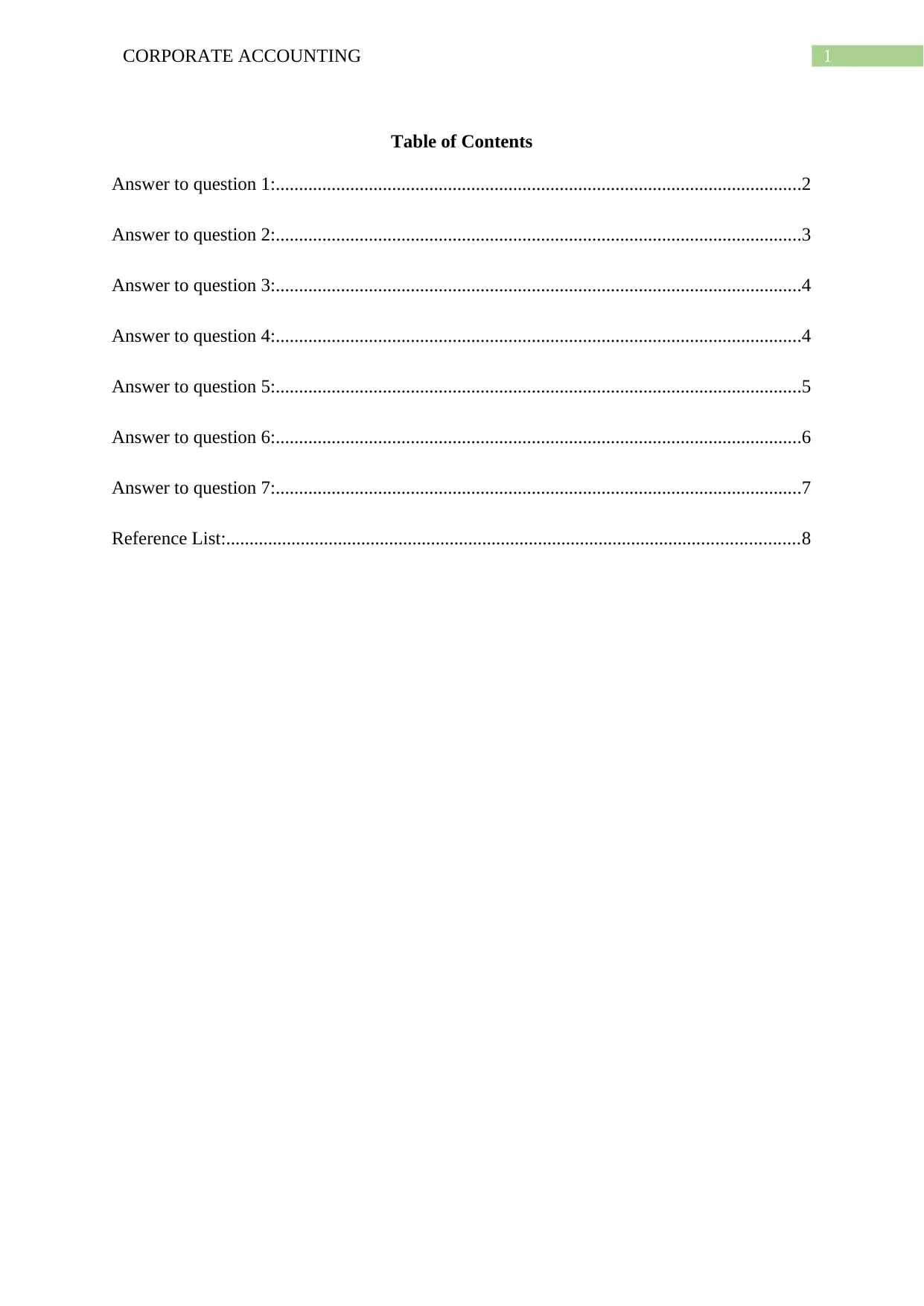
1CORPORATE ACCOUNTING
Table of Contents
Answer to question 1:.................................................................................................................2
Answer to question 2:.................................................................................................................3
Answer to question 3:.................................................................................................................4
Answer to question 4:.................................................................................................................4
Answer to question 5:.................................................................................................................5
Answer to question 6:.................................................................................................................6
Answer to question 7:.................................................................................................................7
Reference List:...........................................................................................................................8
Table of Contents
Answer to question 1:.................................................................................................................2
Answer to question 2:.................................................................................................................3
Answer to question 3:.................................................................................................................4
Answer to question 4:.................................................................................................................4
Answer to question 5:.................................................................................................................5
Answer to question 6:.................................................................................................................6
Answer to question 7:.................................................................................................................7
Reference List:...........................................................................................................................8
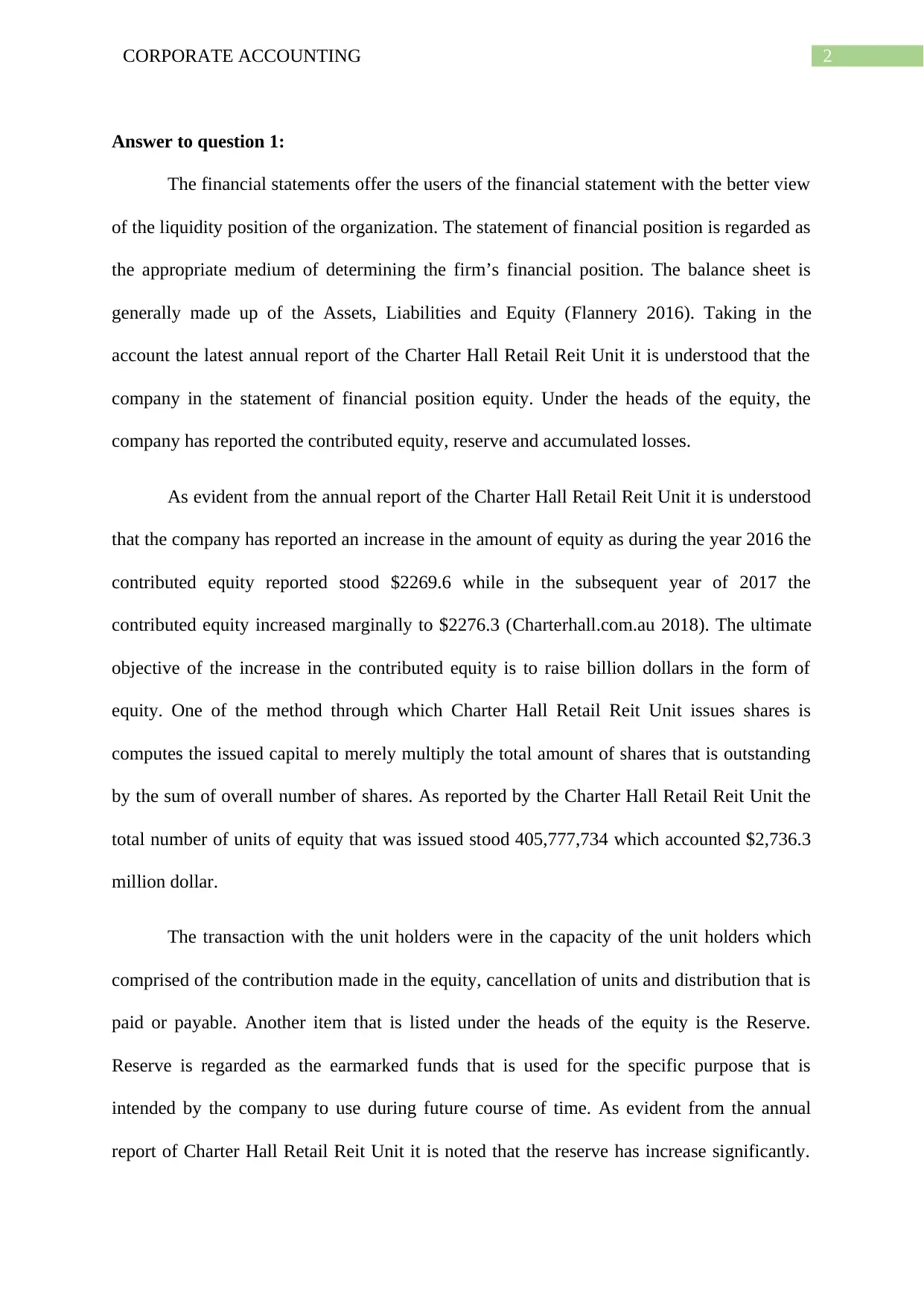
2CORPORATE ACCOUNTING
Answer to question 1:
The financial statements offer the users of the financial statement with the better view
of the liquidity position of the organization. The statement of financial position is regarded as
the appropriate medium of determining the firm’s financial position. The balance sheet is
generally made up of the Assets, Liabilities and Equity (Flannery 2016). Taking in the
account the latest annual report of the Charter Hall Retail Reit Unit it is understood that the
company in the statement of financial position equity. Under the heads of the equity, the
company has reported the contributed equity, reserve and accumulated losses.
As evident from the annual report of the Charter Hall Retail Reit Unit it is understood
that the company has reported an increase in the amount of equity as during the year 2016 the
contributed equity reported stood $2269.6 while in the subsequent year of 2017 the
contributed equity increased marginally to $2276.3 (Charterhall.com.au 2018). The ultimate
objective of the increase in the contributed equity is to raise billion dollars in the form of
equity. One of the method through which Charter Hall Retail Reit Unit issues shares is
computes the issued capital to merely multiply the total amount of shares that is outstanding
by the sum of overall number of shares. As reported by the Charter Hall Retail Reit Unit the
total number of units of equity that was issued stood 405,777,734 which accounted $2,736.3
million dollar.
The transaction with the unit holders were in the capacity of the unit holders which
comprised of the contribution made in the equity, cancellation of units and distribution that is
paid or payable. Another item that is listed under the heads of the equity is the Reserve.
Reserve is regarded as the earmarked funds that is used for the specific purpose that is
intended by the company to use during future course of time. As evident from the annual
report of Charter Hall Retail Reit Unit it is noted that the reserve has increase significantly.
Answer to question 1:
The financial statements offer the users of the financial statement with the better view
of the liquidity position of the organization. The statement of financial position is regarded as
the appropriate medium of determining the firm’s financial position. The balance sheet is
generally made up of the Assets, Liabilities and Equity (Flannery 2016). Taking in the
account the latest annual report of the Charter Hall Retail Reit Unit it is understood that the
company in the statement of financial position equity. Under the heads of the equity, the
company has reported the contributed equity, reserve and accumulated losses.
As evident from the annual report of the Charter Hall Retail Reit Unit it is understood
that the company has reported an increase in the amount of equity as during the year 2016 the
contributed equity reported stood $2269.6 while in the subsequent year of 2017 the
contributed equity increased marginally to $2276.3 (Charterhall.com.au 2018). The ultimate
objective of the increase in the contributed equity is to raise billion dollars in the form of
equity. One of the method through which Charter Hall Retail Reit Unit issues shares is
computes the issued capital to merely multiply the total amount of shares that is outstanding
by the sum of overall number of shares. As reported by the Charter Hall Retail Reit Unit the
total number of units of equity that was issued stood 405,777,734 which accounted $2,736.3
million dollar.
The transaction with the unit holders were in the capacity of the unit holders which
comprised of the contribution made in the equity, cancellation of units and distribution that is
paid or payable. Another item that is listed under the heads of the equity is the Reserve.
Reserve is regarded as the earmarked funds that is used for the specific purpose that is
intended by the company to use during future course of time. As evident from the annual
report of Charter Hall Retail Reit Unit it is noted that the reserve has increase significantly.
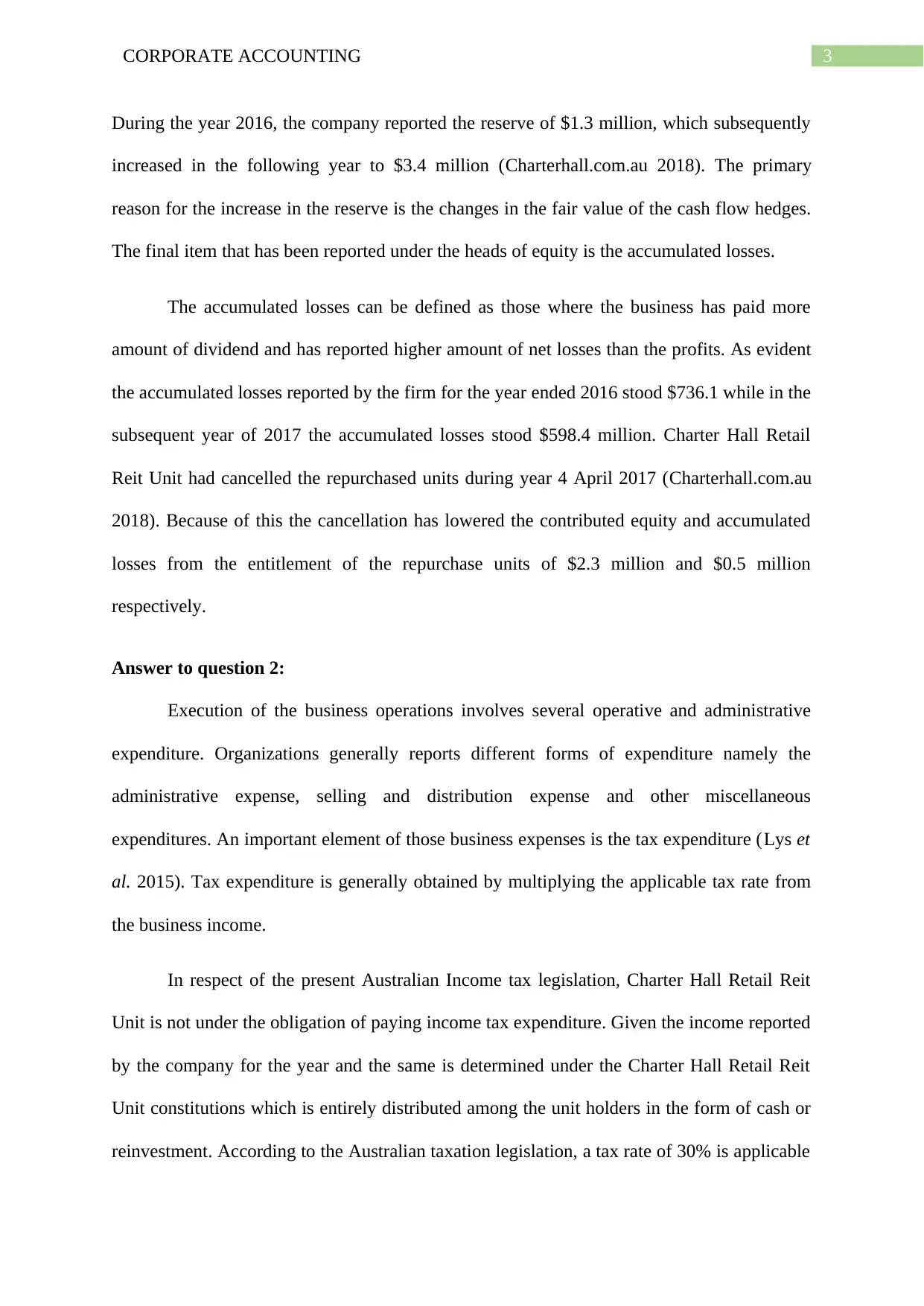
3CORPORATE ACCOUNTING
During the year 2016, the company reported the reserve of $1.3 million, which subsequently
increased in the following year to $3.4 million (Charterhall.com.au 2018). The primary
reason for the increase in the reserve is the changes in the fair value of the cash flow hedges.
The final item that has been reported under the heads of equity is the accumulated losses.
The accumulated losses can be defined as those where the business has paid more
amount of dividend and has reported higher amount of net losses than the profits. As evident
the accumulated losses reported by the firm for the year ended 2016 stood $736.1 while in the
subsequent year of 2017 the accumulated losses stood $598.4 million. Charter Hall Retail
Reit Unit had cancelled the repurchased units during year 4 April 2017 (Charterhall.com.au
2018). Because of this the cancellation has lowered the contributed equity and accumulated
losses from the entitlement of the repurchase units of $2.3 million and $0.5 million
respectively.
Answer to question 2:
Execution of the business operations involves several operative and administrative
expenditure. Organizations generally reports different forms of expenditure namely the
administrative expense, selling and distribution expense and other miscellaneous
expenditures. An important element of those business expenses is the tax expenditure (Lys et
al. 2015). Tax expenditure is generally obtained by multiplying the applicable tax rate from
the business income.
In respect of the present Australian Income tax legislation, Charter Hall Retail Reit
Unit is not under the obligation of paying income tax expenditure. Given the income reported
by the company for the year and the same is determined under the Charter Hall Retail Reit
Unit constitutions which is entirely distributed among the unit holders in the form of cash or
reinvestment. According to the Australian taxation legislation, a tax rate of 30% is applicable
During the year 2016, the company reported the reserve of $1.3 million, which subsequently
increased in the following year to $3.4 million (Charterhall.com.au 2018). The primary
reason for the increase in the reserve is the changes in the fair value of the cash flow hedges.
The final item that has been reported under the heads of equity is the accumulated losses.
The accumulated losses can be defined as those where the business has paid more
amount of dividend and has reported higher amount of net losses than the profits. As evident
the accumulated losses reported by the firm for the year ended 2016 stood $736.1 while in the
subsequent year of 2017 the accumulated losses stood $598.4 million. Charter Hall Retail
Reit Unit had cancelled the repurchased units during year 4 April 2017 (Charterhall.com.au
2018). Because of this the cancellation has lowered the contributed equity and accumulated
losses from the entitlement of the repurchase units of $2.3 million and $0.5 million
respectively.
Answer to question 2:
Execution of the business operations involves several operative and administrative
expenditure. Organizations generally reports different forms of expenditure namely the
administrative expense, selling and distribution expense and other miscellaneous
expenditures. An important element of those business expenses is the tax expenditure (Lys et
al. 2015). Tax expenditure is generally obtained by multiplying the applicable tax rate from
the business income.
In respect of the present Australian Income tax legislation, Charter Hall Retail Reit
Unit is not under the obligation of paying income tax expenditure. Given the income reported
by the company for the year and the same is determined under the Charter Hall Retail Reit
Unit constitutions which is entirely distributed among the unit holders in the form of cash or
reinvestment. According to the Australian taxation legislation, a tax rate of 30% is applicable
Secure Best Marks with AI Grader
Need help grading? Try our AI Grader for instant feedback on your assignments.
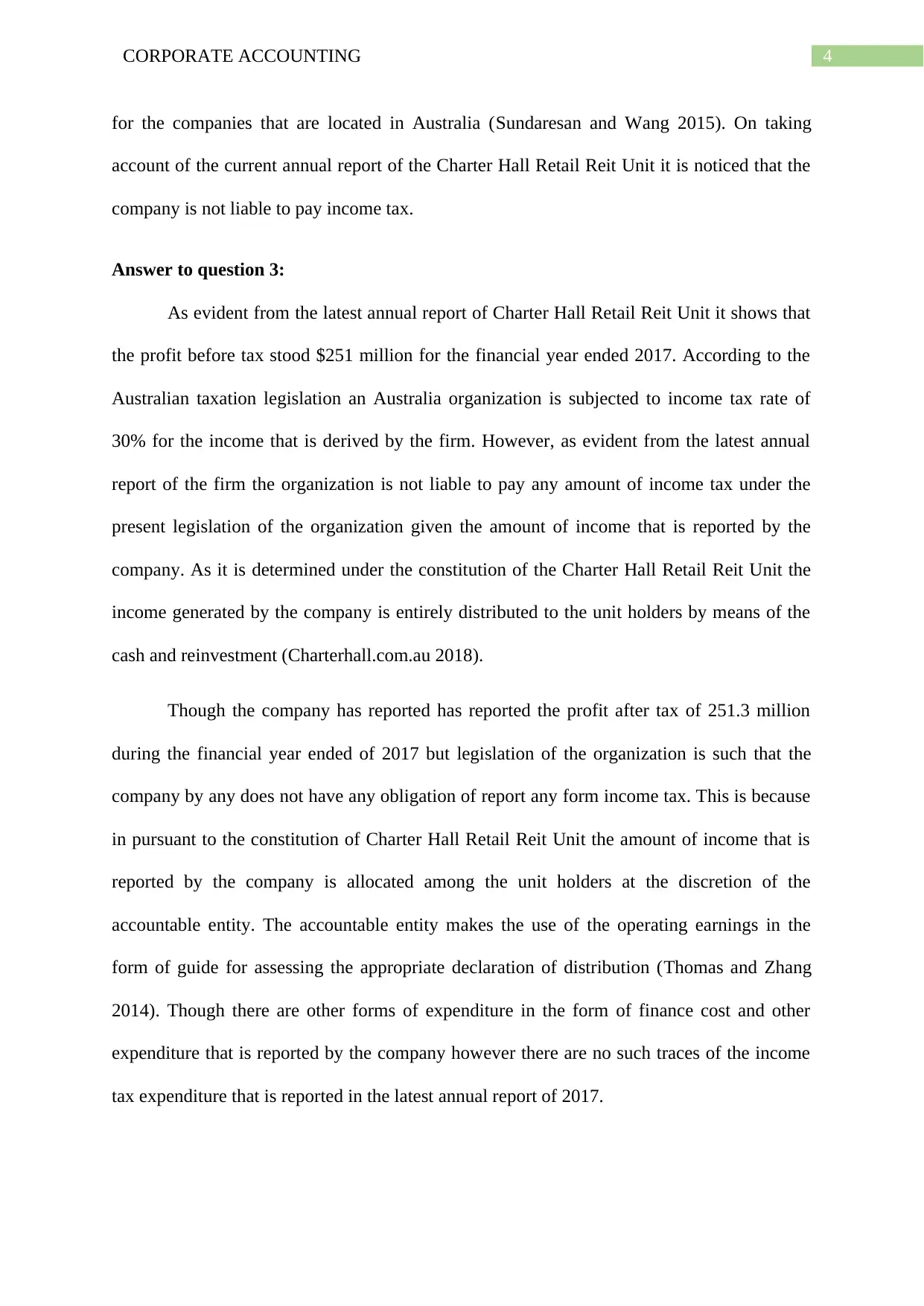
4CORPORATE ACCOUNTING
for the companies that are located in Australia (Sundaresan and Wang 2015). On taking
account of the current annual report of the Charter Hall Retail Reit Unit it is noticed that the
company is not liable to pay income tax.
Answer to question 3:
As evident from the latest annual report of Charter Hall Retail Reit Unit it shows that
the profit before tax stood $251 million for the financial year ended 2017. According to the
Australian taxation legislation an Australia organization is subjected to income tax rate of
30% for the income that is derived by the firm. However, as evident from the latest annual
report of the firm the organization is not liable to pay any amount of income tax under the
present legislation of the organization given the amount of income that is reported by the
company. As it is determined under the constitution of the Charter Hall Retail Reit Unit the
income generated by the company is entirely distributed to the unit holders by means of the
cash and reinvestment (Charterhall.com.au 2018).
Though the company has reported has reported the profit after tax of 251.3 million
during the financial year ended of 2017 but legislation of the organization is such that the
company by any does not have any obligation of report any form income tax. This is because
in pursuant to the constitution of Charter Hall Retail Reit Unit the amount of income that is
reported by the company is allocated among the unit holders at the discretion of the
accountable entity. The accountable entity makes the use of the operating earnings in the
form of guide for assessing the appropriate declaration of distribution (Thomas and Zhang
2014). Though there are other forms of expenditure in the form of finance cost and other
expenditure that is reported by the company however there are no such traces of the income
tax expenditure that is reported in the latest annual report of 2017.
for the companies that are located in Australia (Sundaresan and Wang 2015). On taking
account of the current annual report of the Charter Hall Retail Reit Unit it is noticed that the
company is not liable to pay income tax.
Answer to question 3:
As evident from the latest annual report of Charter Hall Retail Reit Unit it shows that
the profit before tax stood $251 million for the financial year ended 2017. According to the
Australian taxation legislation an Australia organization is subjected to income tax rate of
30% for the income that is derived by the firm. However, as evident from the latest annual
report of the firm the organization is not liable to pay any amount of income tax under the
present legislation of the organization given the amount of income that is reported by the
company. As it is determined under the constitution of the Charter Hall Retail Reit Unit the
income generated by the company is entirely distributed to the unit holders by means of the
cash and reinvestment (Charterhall.com.au 2018).
Though the company has reported has reported the profit after tax of 251.3 million
during the financial year ended of 2017 but legislation of the organization is such that the
company by any does not have any obligation of report any form income tax. This is because
in pursuant to the constitution of Charter Hall Retail Reit Unit the amount of income that is
reported by the company is allocated among the unit holders at the discretion of the
accountable entity. The accountable entity makes the use of the operating earnings in the
form of guide for assessing the appropriate declaration of distribution (Thomas and Zhang
2014). Though there are other forms of expenditure in the form of finance cost and other
expenditure that is reported by the company however there are no such traces of the income
tax expenditure that is reported in the latest annual report of 2017.
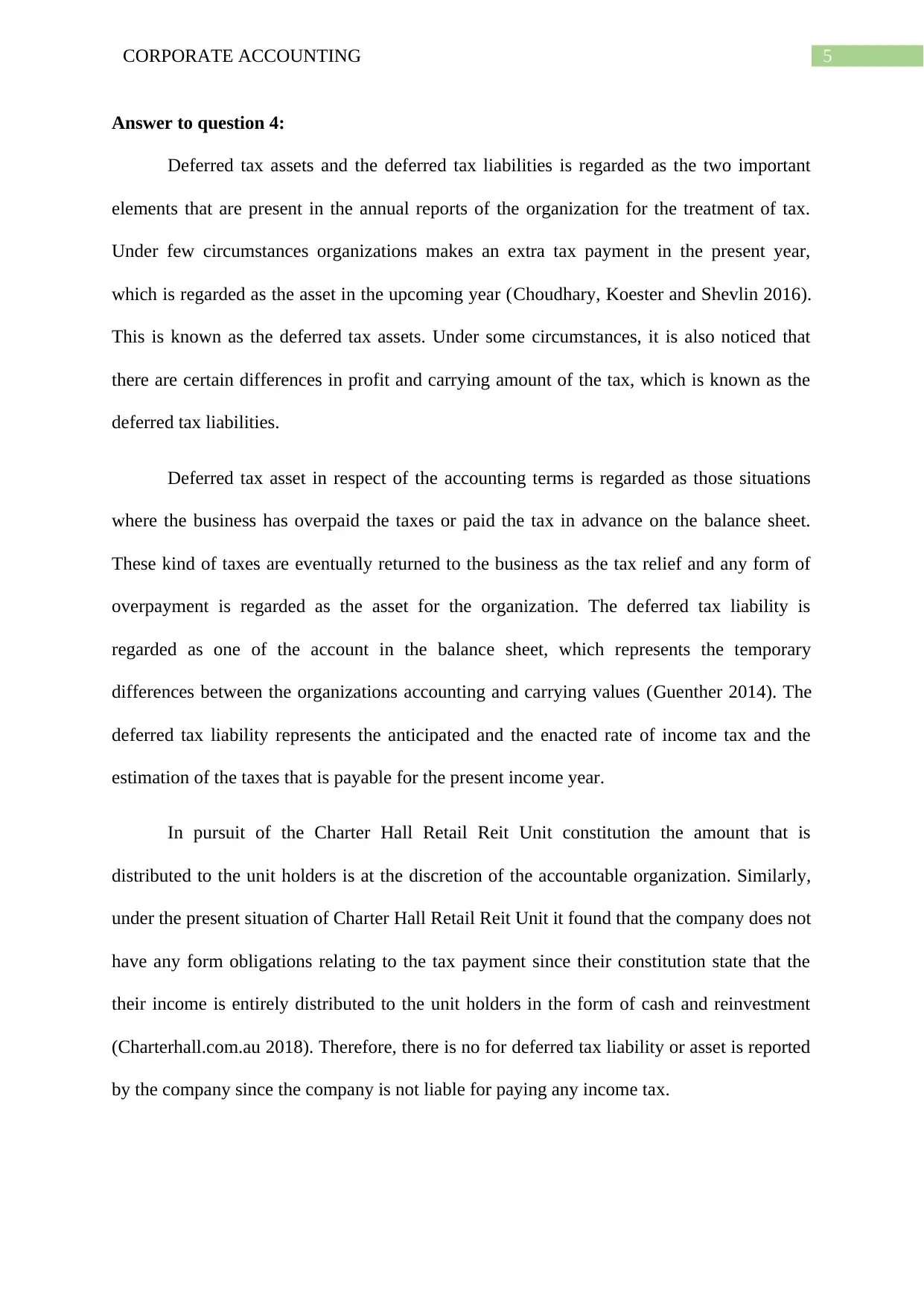
5CORPORATE ACCOUNTING
Answer to question 4:
Deferred tax assets and the deferred tax liabilities is regarded as the two important
elements that are present in the annual reports of the organization for the treatment of tax.
Under few circumstances organizations makes an extra tax payment in the present year,
which is regarded as the asset in the upcoming year (Choudhary, Koester and Shevlin 2016).
This is known as the deferred tax assets. Under some circumstances, it is also noticed that
there are certain differences in profit and carrying amount of the tax, which is known as the
deferred tax liabilities.
Deferred tax asset in respect of the accounting terms is regarded as those situations
where the business has overpaid the taxes or paid the tax in advance on the balance sheet.
These kind of taxes are eventually returned to the business as the tax relief and any form of
overpayment is regarded as the asset for the organization. The deferred tax liability is
regarded as one of the account in the balance sheet, which represents the temporary
differences between the organizations accounting and carrying values (Guenther 2014). The
deferred tax liability represents the anticipated and the enacted rate of income tax and the
estimation of the taxes that is payable for the present income year.
In pursuit of the Charter Hall Retail Reit Unit constitution the amount that is
distributed to the unit holders is at the discretion of the accountable organization. Similarly,
under the present situation of Charter Hall Retail Reit Unit it found that the company does not
have any form obligations relating to the tax payment since their constitution state that the
their income is entirely distributed to the unit holders in the form of cash and reinvestment
(Charterhall.com.au 2018). Therefore, there is no for deferred tax liability or asset is reported
by the company since the company is not liable for paying any income tax.
Answer to question 4:
Deferred tax assets and the deferred tax liabilities is regarded as the two important
elements that are present in the annual reports of the organization for the treatment of tax.
Under few circumstances organizations makes an extra tax payment in the present year,
which is regarded as the asset in the upcoming year (Choudhary, Koester and Shevlin 2016).
This is known as the deferred tax assets. Under some circumstances, it is also noticed that
there are certain differences in profit and carrying amount of the tax, which is known as the
deferred tax liabilities.
Deferred tax asset in respect of the accounting terms is regarded as those situations
where the business has overpaid the taxes or paid the tax in advance on the balance sheet.
These kind of taxes are eventually returned to the business as the tax relief and any form of
overpayment is regarded as the asset for the organization. The deferred tax liability is
regarded as one of the account in the balance sheet, which represents the temporary
differences between the organizations accounting and carrying values (Guenther 2014). The
deferred tax liability represents the anticipated and the enacted rate of income tax and the
estimation of the taxes that is payable for the present income year.
In pursuit of the Charter Hall Retail Reit Unit constitution the amount that is
distributed to the unit holders is at the discretion of the accountable organization. Similarly,
under the present situation of Charter Hall Retail Reit Unit it found that the company does not
have any form obligations relating to the tax payment since their constitution state that the
their income is entirely distributed to the unit holders in the form of cash and reinvestment
(Charterhall.com.au 2018). Therefore, there is no for deferred tax liability or asset is reported
by the company since the company is not liable for paying any income tax.
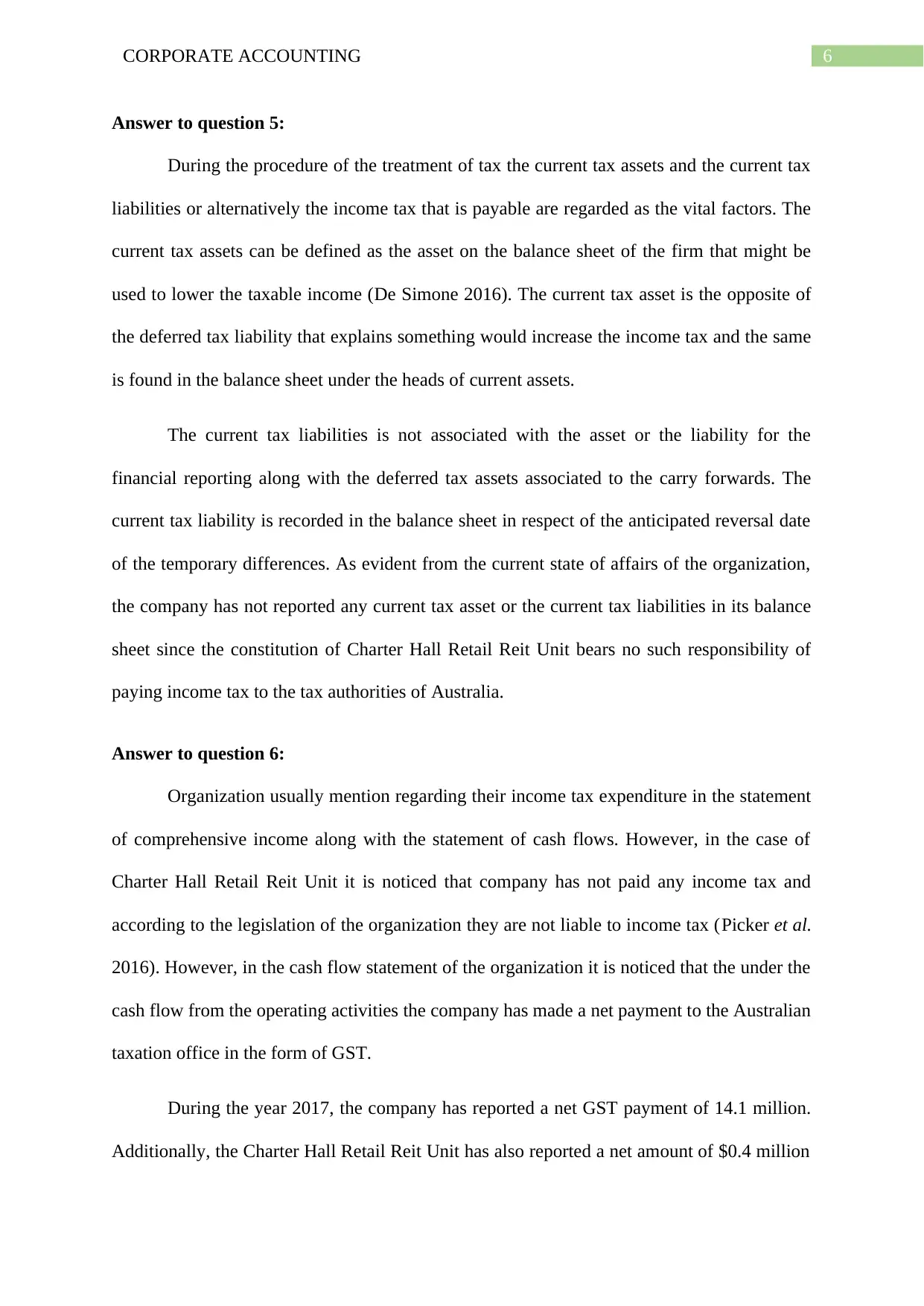
6CORPORATE ACCOUNTING
Answer to question 5:
During the procedure of the treatment of tax the current tax assets and the current tax
liabilities or alternatively the income tax that is payable are regarded as the vital factors. The
current tax assets can be defined as the asset on the balance sheet of the firm that might be
used to lower the taxable income (De Simone 2016). The current tax asset is the opposite of
the deferred tax liability that explains something would increase the income tax and the same
is found in the balance sheet under the heads of current assets.
The current tax liabilities is not associated with the asset or the liability for the
financial reporting along with the deferred tax assets associated to the carry forwards. The
current tax liability is recorded in the balance sheet in respect of the anticipated reversal date
of the temporary differences. As evident from the current state of affairs of the organization,
the company has not reported any current tax asset or the current tax liabilities in its balance
sheet since the constitution of Charter Hall Retail Reit Unit bears no such responsibility of
paying income tax to the tax authorities of Australia.
Answer to question 6:
Organization usually mention regarding their income tax expenditure in the statement
of comprehensive income along with the statement of cash flows. However, in the case of
Charter Hall Retail Reit Unit it is noticed that company has not paid any income tax and
according to the legislation of the organization they are not liable to income tax (Picker et al.
2016). However, in the cash flow statement of the organization it is noticed that the under the
cash flow from the operating activities the company has made a net payment to the Australian
taxation office in the form of GST.
During the year 2017, the company has reported a net GST payment of 14.1 million.
Additionally, the Charter Hall Retail Reit Unit has also reported a net amount of $0.4 million
Answer to question 5:
During the procedure of the treatment of tax the current tax assets and the current tax
liabilities or alternatively the income tax that is payable are regarded as the vital factors. The
current tax assets can be defined as the asset on the balance sheet of the firm that might be
used to lower the taxable income (De Simone 2016). The current tax asset is the opposite of
the deferred tax liability that explains something would increase the income tax and the same
is found in the balance sheet under the heads of current assets.
The current tax liabilities is not associated with the asset or the liability for the
financial reporting along with the deferred tax assets associated to the carry forwards. The
current tax liability is recorded in the balance sheet in respect of the anticipated reversal date
of the temporary differences. As evident from the current state of affairs of the organization,
the company has not reported any current tax asset or the current tax liabilities in its balance
sheet since the constitution of Charter Hall Retail Reit Unit bears no such responsibility of
paying income tax to the tax authorities of Australia.
Answer to question 6:
Organization usually mention regarding their income tax expenditure in the statement
of comprehensive income along with the statement of cash flows. However, in the case of
Charter Hall Retail Reit Unit it is noticed that company has not paid any income tax and
according to the legislation of the organization they are not liable to income tax (Picker et al.
2016). However, in the cash flow statement of the organization it is noticed that the under the
cash flow from the operating activities the company has made a net payment to the Australian
taxation office in the form of GST.
During the year 2017, the company has reported a net GST payment of 14.1 million.
Additionally, the Charter Hall Retail Reit Unit has also reported a net amount of $0.4 million
Paraphrase This Document
Need a fresh take? Get an instant paraphrase of this document with our AI Paraphraser
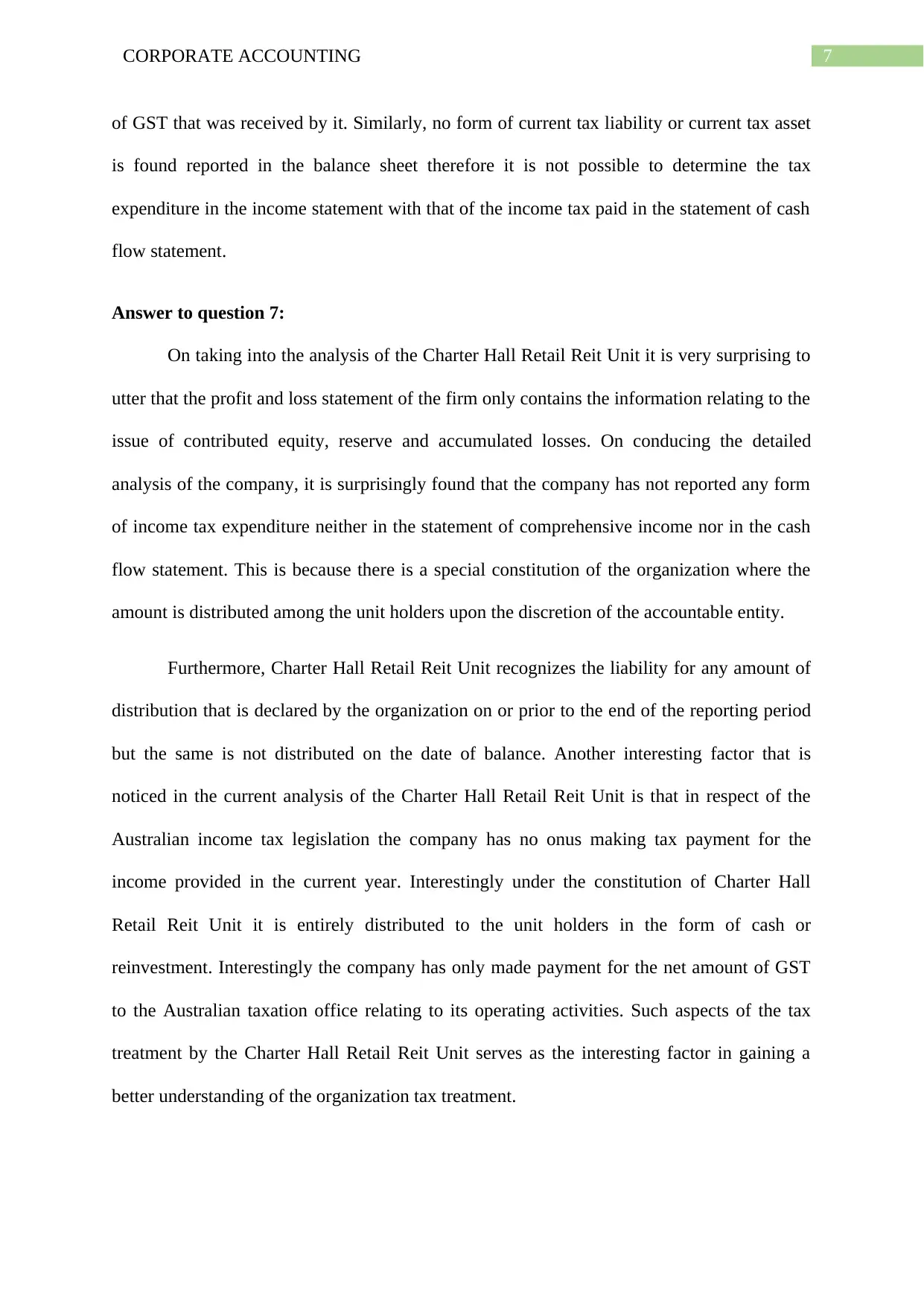
7CORPORATE ACCOUNTING
of GST that was received by it. Similarly, no form of current tax liability or current tax asset
is found reported in the balance sheet therefore it is not possible to determine the tax
expenditure in the income statement with that of the income tax paid in the statement of cash
flow statement.
Answer to question 7:
On taking into the analysis of the Charter Hall Retail Reit Unit it is very surprising to
utter that the profit and loss statement of the firm only contains the information relating to the
issue of contributed equity, reserve and accumulated losses. On conducing the detailed
analysis of the company, it is surprisingly found that the company has not reported any form
of income tax expenditure neither in the statement of comprehensive income nor in the cash
flow statement. This is because there is a special constitution of the organization where the
amount is distributed among the unit holders upon the discretion of the accountable entity.
Furthermore, Charter Hall Retail Reit Unit recognizes the liability for any amount of
distribution that is declared by the organization on or prior to the end of the reporting period
but the same is not distributed on the date of balance. Another interesting factor that is
noticed in the current analysis of the Charter Hall Retail Reit Unit is that in respect of the
Australian income tax legislation the company has no onus making tax payment for the
income provided in the current year. Interestingly under the constitution of Charter Hall
Retail Reit Unit it is entirely distributed to the unit holders in the form of cash or
reinvestment. Interestingly the company has only made payment for the net amount of GST
to the Australian taxation office relating to its operating activities. Such aspects of the tax
treatment by the Charter Hall Retail Reit Unit serves as the interesting factor in gaining a
better understanding of the organization tax treatment.
of GST that was received by it. Similarly, no form of current tax liability or current tax asset
is found reported in the balance sheet therefore it is not possible to determine the tax
expenditure in the income statement with that of the income tax paid in the statement of cash
flow statement.
Answer to question 7:
On taking into the analysis of the Charter Hall Retail Reit Unit it is very surprising to
utter that the profit and loss statement of the firm only contains the information relating to the
issue of contributed equity, reserve and accumulated losses. On conducing the detailed
analysis of the company, it is surprisingly found that the company has not reported any form
of income tax expenditure neither in the statement of comprehensive income nor in the cash
flow statement. This is because there is a special constitution of the organization where the
amount is distributed among the unit holders upon the discretion of the accountable entity.
Furthermore, Charter Hall Retail Reit Unit recognizes the liability for any amount of
distribution that is declared by the organization on or prior to the end of the reporting period
but the same is not distributed on the date of balance. Another interesting factor that is
noticed in the current analysis of the Charter Hall Retail Reit Unit is that in respect of the
Australian income tax legislation the company has no onus making tax payment for the
income provided in the current year. Interestingly under the constitution of Charter Hall
Retail Reit Unit it is entirely distributed to the unit holders in the form of cash or
reinvestment. Interestingly the company has only made payment for the net amount of GST
to the Australian taxation office relating to its operating activities. Such aspects of the tax
treatment by the Charter Hall Retail Reit Unit serves as the interesting factor in gaining a
better understanding of the organization tax treatment.
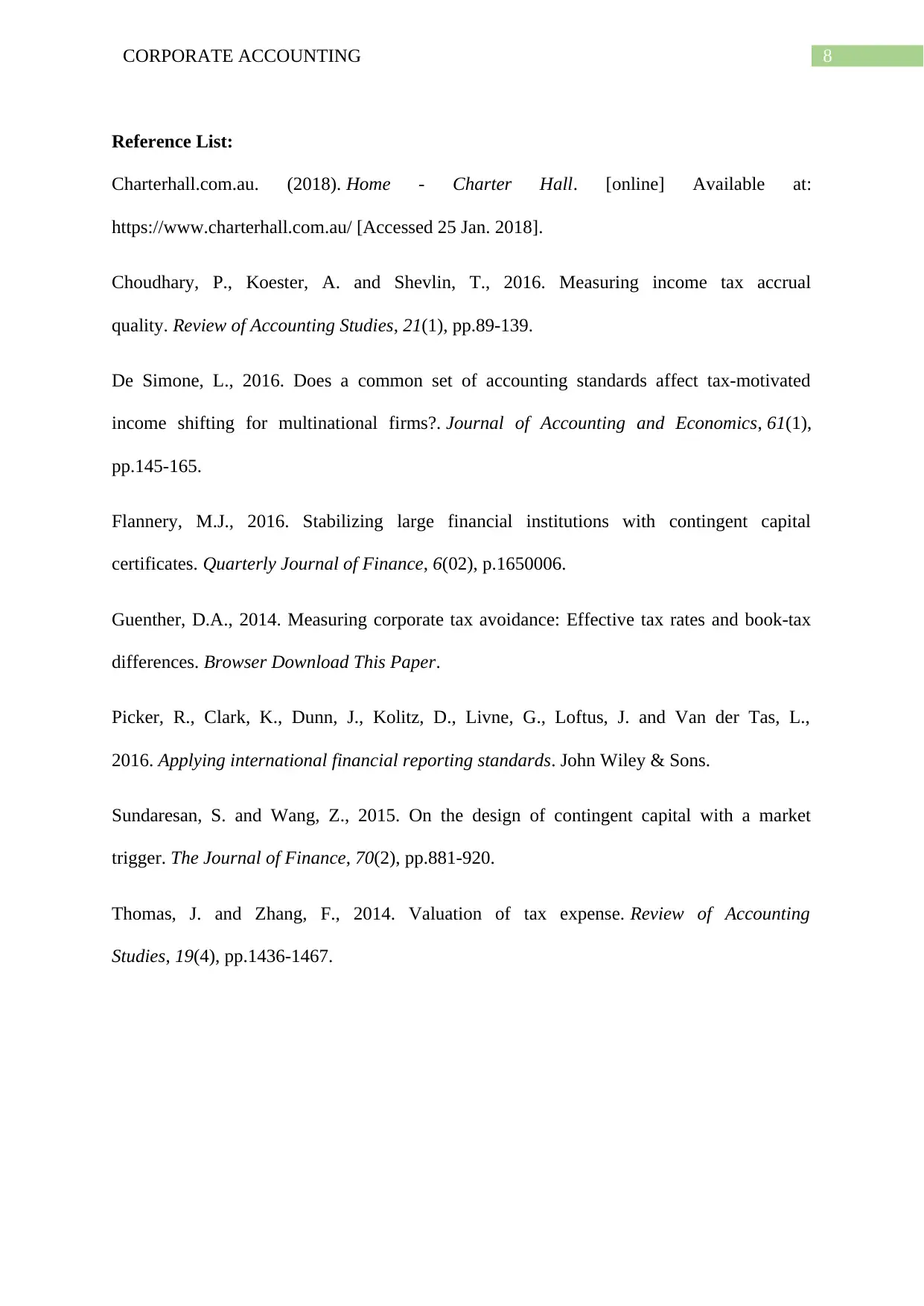
8CORPORATE ACCOUNTING
Reference List:
Charterhall.com.au. (2018). Home - Charter Hall. [online] Available at:
https://www.charterhall.com.au/ [Accessed 25 Jan. 2018].
Choudhary, P., Koester, A. and Shevlin, T., 2016. Measuring income tax accrual
quality. Review of Accounting Studies, 21(1), pp.89-139.
De Simone, L., 2016. Does a common set of accounting standards affect tax-motivated
income shifting for multinational firms?. Journal of Accounting and Economics, 61(1),
pp.145-165.
Flannery, M.J., 2016. Stabilizing large financial institutions with contingent capital
certificates. Quarterly Journal of Finance, 6(02), p.1650006.
Guenther, D.A., 2014. Measuring corporate tax avoidance: Effective tax rates and book-tax
differences. Browser Download This Paper.
Picker, R., Clark, K., Dunn, J., Kolitz, D., Livne, G., Loftus, J. and Van der Tas, L.,
2016. Applying international financial reporting standards. John Wiley & Sons.
Sundaresan, S. and Wang, Z., 2015. On the design of contingent capital with a market
trigger. The Journal of Finance, 70(2), pp.881-920.
Thomas, J. and Zhang, F., 2014. Valuation of tax expense. Review of Accounting
Studies, 19(4), pp.1436-1467.
Reference List:
Charterhall.com.au. (2018). Home - Charter Hall. [online] Available at:
https://www.charterhall.com.au/ [Accessed 25 Jan. 2018].
Choudhary, P., Koester, A. and Shevlin, T., 2016. Measuring income tax accrual
quality. Review of Accounting Studies, 21(1), pp.89-139.
De Simone, L., 2016. Does a common set of accounting standards affect tax-motivated
income shifting for multinational firms?. Journal of Accounting and Economics, 61(1),
pp.145-165.
Flannery, M.J., 2016. Stabilizing large financial institutions with contingent capital
certificates. Quarterly Journal of Finance, 6(02), p.1650006.
Guenther, D.A., 2014. Measuring corporate tax avoidance: Effective tax rates and book-tax
differences. Browser Download This Paper.
Picker, R., Clark, K., Dunn, J., Kolitz, D., Livne, G., Loftus, J. and Van der Tas, L.,
2016. Applying international financial reporting standards. John Wiley & Sons.
Sundaresan, S. and Wang, Z., 2015. On the design of contingent capital with a market
trigger. The Journal of Finance, 70(2), pp.881-920.
Thomas, J. and Zhang, F., 2014. Valuation of tax expense. Review of Accounting
Studies, 19(4), pp.1436-1467.
1 out of 9
Related Documents
Your All-in-One AI-Powered Toolkit for Academic Success.
+13062052269
info@desklib.com
Available 24*7 on WhatsApp / Email
![[object Object]](/_next/static/media/star-bottom.7253800d.svg)
Unlock your academic potential
© 2024 | Zucol Services PVT LTD | All rights reserved.




